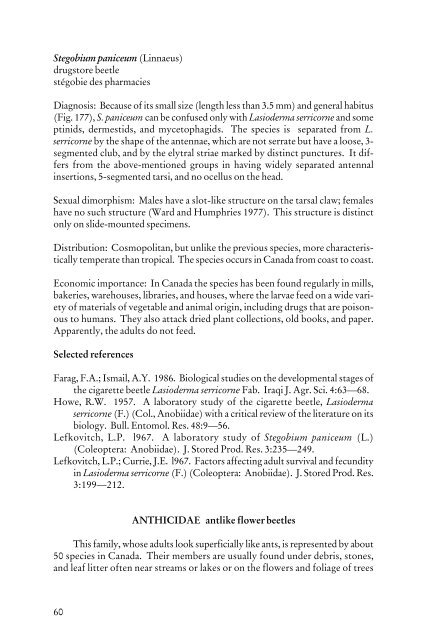Beetles Identification Guide
Beetles Identification Guide
Beetles Identification Guide
You also want an ePaper? Increase the reach of your titles
YUMPU automatically turns print PDFs into web optimized ePapers that Google loves.
Stegobium paniceum (Linnaeus)<br />
drugstore beetle<br />
stégobie des pharmacies<br />
Diagnosis: Because of its small size (length less than 3.5 mm) and general habitus<br />
(Fig. 177), S. paniceum can be confused only with Lasioderma serricorne and some<br />
ptinids, dermestids, and mycetophagids. The species is separated from L.<br />
serricorne by the shape of the antennae, which are not serrate but have a loose, 3segmented<br />
club, and by the elytral striae marked by distinct punctures. It differs<br />
from the above-mentioned groups in having widely separated antennal<br />
insertions, 5-segmented tarsi, and no ocellus on the head.<br />
Sexual dimorphism: Males have a slot-like structure on the tarsal claw; females<br />
have no such structure (Ward and Humphries 1977). This structure is distinct<br />
only on slide-mounted specimens.<br />
Distribution: Cosmopolitan, but unlike the previous species, more characteristically<br />
temperate than tropical. The species occurs in Canada from coast to coast.<br />
Economic importance: In Canada the species has been found regularly in mills,<br />
bakeries, warehouses, libraries, and houses, where the larvae feed on a wide variety<br />
of materials of vegetable and animal origin, including drugs that are poisonous<br />
to humans. They also attack dried plant collections, old books, and paper.<br />
Apparently, the adults do not feed.<br />
Selected references<br />
Farag, F.A.; Ismail, A.Y. 1986. Biological studies on the developmental stages of<br />
the cigarette beetle Lasioderma serricorne Fab. Iraqi J. Agr. Sci. 4:63—68.<br />
Howe, R.W. 1957. A laboratory study of the cigarette beetle, Lasioderma<br />
serricorne (F.) (Col., Anobiidae) with a critical review of the literature on its<br />
biology. Bull. Entomol. Res. 48:9—56.<br />
Lefkovitch, L.P. l967. A laboratory study of Stegobium paniceum (L.)<br />
(Coleoptera: Anobiidae). J. Stored Prod. Res. 3:235—249.<br />
Lefkovitch, L.P.; Currie, J.E. l967. Factors affecting adult survival and fecundity<br />
in Lasioderma serricorne (F.) (Coleoptera: Anobiidae). J. Stored Prod. Res.<br />
3:199—212.<br />
60<br />
ANTHICIDAE antlike flower beetles<br />
This family, whose adults look superficially like ants, is represented by about<br />
50 species in Canada. Their members are usually found under debris, stones,<br />
and leaf litter often near streams or lakes or on the flowers and foliage of trees
















